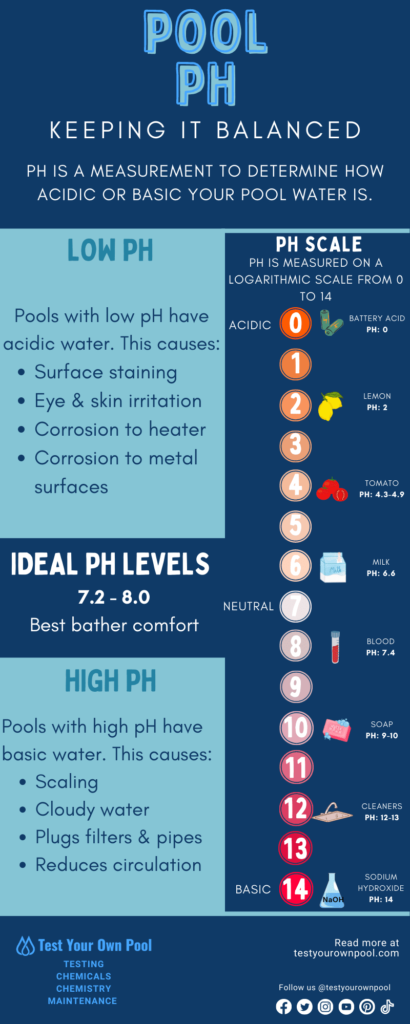pH is a measurement to determine how acidic or basic (“alkaline”) pool water can get. Scientifically speaking, pH measures the number of free hydrogen ions or hydroxyl ions in the water.
Water with more free hydrogen ions is acidic, and conversely, basic water includes water with more free hydroxyl ions (luckily, you don’t need to know what any of that means!).
Knowing what pH is and how it can affect pool water is part of achieving overall water balance.
How pH Can Affect Pool Chemistry
pH is measured on a logarithmic scale from 0 to 14, meaning each unit increase is 10 times the previous number (5 is 10 times more acidic than 6, while 4 is 1,000 more acidic than 7.)
A pH of 7 is considered “neutral”, so anything below 7 is acidic water, and above 7 is basic water.
The acidity or basicity of water is extremely important when it comes to overall water balance and swimming comfort. Anything outside preferred levels can be very discomforting for swimmers, from itchy skin to overall eye irritation. pH is also the most important factor when it comes to the corrosion of water.
Pools with a low pH (acidic water) can do some serious damage to equipment, from dissolving metal surfaces like ladders to wrinkling pool liners. Similarly, higher pH levels (basic water) can introduce scaling, reduce circulation and cause water cloudiness.
Testing the water with a proper testing kit will be the key to keeping pH in balance at all times.
Total Alkalinity’s Role
pH isn’t as effective without some help. It needs some kind of “buffer” in the water so it doesn’t dramatically change over some time. This is where total alkalinity’s (TA) role comes into play.
TA is a measure of water’s ability to resist changes in pH. Simply put, it is that buffer to protect against wild pH swings. Water without a buffer will cause pH to dramatically change so pH and TA must work together to find a balance.
Testing for pH
Any good test strip or testing kit can ensure correct pH levels. Since we want the most accurate results for pH, a testing kit is the recommended choice. pH is too important to have a range of “guesstimates” of where it currently is.
Testing pH more frequently is highly recommended because of the tendency for pH to constantly drift upwards. pH levels will not be stable throughout the swimming season since just simple water aeration like water features and splashing will cause pH to rise.
Pool owners with newly resurfaced plaster finish can experience pH rise for well over a year, so daily testing (sometimes twice or three times a day) may be necessary until levels start to balance for a longer period.
Know Your Fill Water Source
It is not uncommon for the need to fill your pool every so often with tap or hose water. Evaporation and excessive “fun having” will require a fill-up. You should be testing the fill water for pH, and for total alkalinity, and calcium hardness for that matter. This will ensure no surprises and should give you better expectations of water chemistry after the fill is complete.
What is an Ideal pH Level?
pH should fall slightly above neutral (7) and be a little more basic than acidic. This promotes better bather comfort and equipment generally lasts longer in less acidic water. Generally, it is ideal to keep the pH between 7.2 to 8.0. Anything drifting outside of that can be very uncomfortable for swimmers and equipment.
With pH, no one pool is the same, so it is advisable to find a pH level that remains stable or settles, over time. If that sweet spot is 7.5 to 8.1, then that is OK. What you don’t want is to stick to a number and continuously dump chemicals to chase that level. Let the water find its preference and go from there.
How to lower pH
pH can be lowered in the pool by using either muriatic acid or dry acid. If you intend to use muriatic acid, precautions must be taken when handling and dumping it into the pool. Use proper PPE: gloves, goggles, and wear a mask as the fumes can be overwhelming and dangerous to breathe in. Also want to make sure you are storing it in a dark, cool place away from the chlorine.
Dry acid can usually be found in pool stores under the names “pH down” or “pH decreaser”.
Be mindful that if using acid, TA levels will also lower so make sure you test both afterward.
How to Raise pH
The easiest way to raise pH in the pool is to have a party. Aeration will naturally cause pH to rise gradually, while also not affecting TA levels.
Another common way is to use borax, a common laundry detergent cleaning agent. It can be found in most grocery stores in the detergent aisle under the name 20 Mule Team.
Lastly, soda ash can raise pH, but keep in mind this will also raise TA.
Keep Testing
Most of the issues stated above aren’t meant to scare or cause any nerves; they are simply meant to underscore the importance of testing and understanding how your water behaves every week. Your pH will shift which is out of your control, but it is up to you to monitor these shifts and make sure that it doesn’t get too out of hand!

